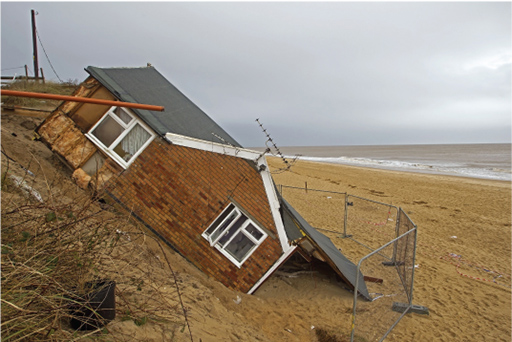4.3 Potential problems with insurance
Increasingly risk-based pricing is the natural direction of travel in commercial insurance markets. The development of – and improvement in – flood risk estimation and flood mapping is improving the quality and granularity of data and driving a process of increasing risk segmentation. For example, prior to the government initiative to intervene in the flood insurance market, which you will study in Section 5, while the average price of buildings insurance was estimated at £176 to £232 a year (AA British Insurance Premium Index, 2013, cited in DEFRA, 2013), households in flood risk areas could be paying premiums of £1200 to £1500 (Mark Hoban, cited in Environment, Food and Rural Affairs Committee, 2016).
Risk-based pricing addresses the problem of adverse selection. This is a type of vicious cycle where the pool of people insured becomes skewed towards those with the highest risk of claiming rather than being spread across a mix of policyholders ranging from low to high risk.
What lies behind adverse selection is asymmetric information, a concept you looked at earlier this course in the context of buying homes on flood plains. But with insurance, the concern is not information that the buyer lacks, rather it is the information that the buyer – the household wanting to buy insurance – has, which is not known by the insurer.
Activity 8: Asymmetric information and adverse selection
1. Why would asymmetric information be a problem for a flood insurer?
Answer
Insurers fear that prospective customers have information about the risk of their claiming which the insurer is not party to. For example, if householders suspect their homes might flood, they will be more inclined to buy insurance against this risk. Householders who perceive their homes to be safe from flooding will be less likely to take out cover. This will skew the insurance pool towards higher risks.
2. Why might adverse selection be a problem under a risk-pooling approach to flood insurance?
Answer
Under risk pooling, the same or similar premium is charged to everyone and includes a cross subsidy from those at lower risk to those at higher risk. The premium will look too high to the customers who perceive themselves to be low risk, but a bargain for higher-risk customers. As the pool becomes skewed towards higher-risk policyholders, claims will rise. To cover the cost of rising claims, the insurer will need to raise the premium, which will deter even more lower risk customers, and so the process will go on.
a.
Make insurance compulsory
b.
Risk-based pricing
c.
Require insurance applicants to disclose information they have about the risk.
d.
Develop effective flood maps
The correct answers are a, b, c and d.
Answer
All the answers are correct. Making insurance compulsory forces a wide spread of risk in the pool and cross-subsidy between the different risks. With risk-based pricing, lower-risk customers pay less and higher-risk customers pay more, in the process reducing or eliminating the cross-subsidy, so that all customers reckon the policy to be good value relative to the risk. The ability to charge accurate risk-based premiums depends on access to good data. This includes any information about the risk that the policyholder has, which can be gathered by asking insurance applicants relevant questions, but also by gathering data from other sources, such as effective flood-risk estimating and mapping.
A further potential problem with insurance is moral hazard. You considered earlier (in Section 2.2) that households might be displaying moral hazard when they buy homes on a flood plain if they are assuming someone else (such as the government or insurers) will bear the financial cost of their decision should they be affected by flooding. Similarly, households may fail to spend money on making their homes more flood resilient if they know they can rely on insurance to cover the cost of repairs. Ways that insurers might try to reduce moral hazard include, for example, reducing the premium or policy excess for households that have taken steps to make their homes more flood resilient, and charging lower premiums for homes in areas with better flood defences.

